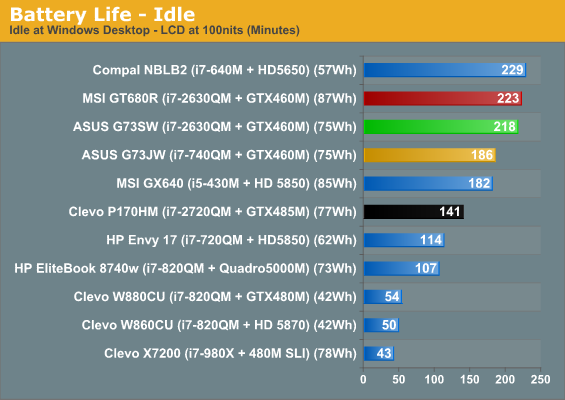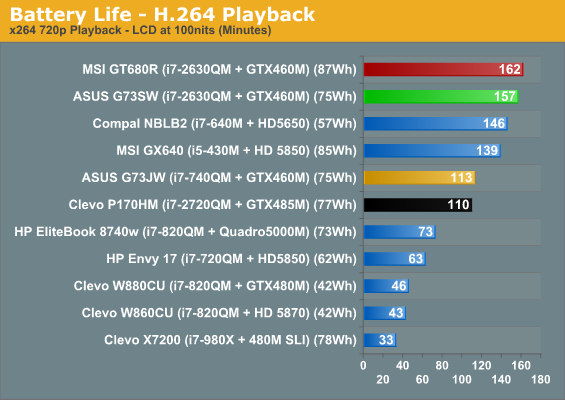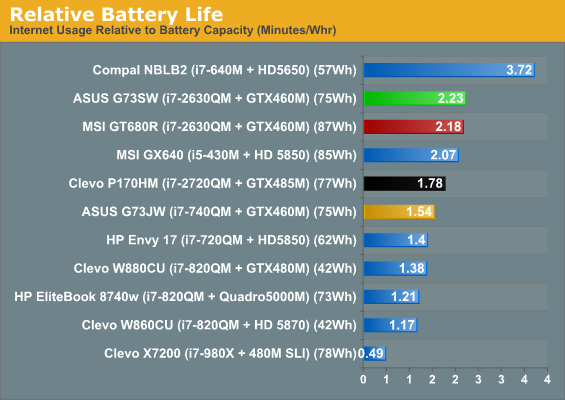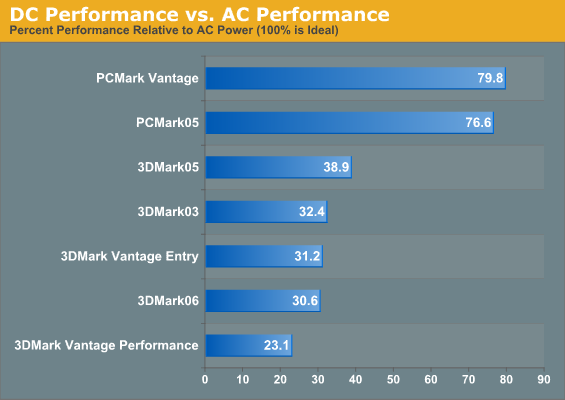ASUS G73SW + SNB: Third Time’s the Charm?
by Jarred Walton on March 4, 2011 12:00 AM ESTBattery Life
The G73 is a 17.3” notebook chassis with a 75Wh battery; we know what that means, right? You’re not going to get all-day computing, or even half a day (unless you have a six-hour workday). We also know that Sandy Bridge is more power efficient than Clarksfield, so we should see some gains relative to the G73JW. And that’s exactly what we get.




Idle battery life is up 17% to 3.75 hours, and that’s the smallest increase. Internet battery life is up 27%, though it falls just shy of the three-hour mark, and H.264 decoding is up 39% to over 2.5 hours. While those are all fairly impressive increases over the previous generation, let’s not lose sight of what we could get with switchable graphics. A vanilla i7-2820QM notebook running off the HD 3000 IGP manages roughly double the runtime in our battery life testing, and that’s with a slightly smaller battery.
We can actually estimate the idle power requirements of the GTX 460M based off of those results, and let me tell ya, it ain’t pretty. Based on the 71Wh battery and the various test results, the Compal SNB notebook we tested used an average of 9.04W at idle, 10.24W in the Internet test, and 16.38W in H.264 playback. In comparison, the G73SW averages 20.64W idle, 26.95W Internet, and 28.66W in H.264 decoding. That means the GTX 460M requires roughly 10W at idle with very low clocks (50MHz core, 270MHz RAM), around 15W with a web browser showing Flash advertisements, and the difference between HD 3000 and GTX 460M in H.264 encoding is back to ~10W. Sadly, these high-power GPUs just aren’t very friendly to battery life, with just the GPU using about as much power as the rest of the notebook combined. Here’s where NVIDIA’s Optimus Technology would have been useful: twice the battery life, the ability to use Intel’s QuickSync technology, and discrete graphics performance when you want it.
Plugged in power numbrs are all higher, as the GPU isn't in "limp mode" and we also ran the LCD at maximum brightness. At idle, we measured 27W at the outlet using a Kill-A-Watt device; taking into account power adapter inefficiency, that figure matches up pretty well with our above calculation. When we put a 100% load on just the CPU (using Cinebench 11.5 SMP), power draw gets as high as 87W. Running through the various 3DMark tests, we saw a maximum "typical gaming" load of 114W, whereas Furmark manages to push the GPU just a little harder and we measured up to 125W. It's also interesting to note that we couldn't get power draw any higher by running Furmark with a CPU loading utility; the CPU load was apparently enough to reduce Furmark performance and so our "worst-case" CPU+GPU load actually dropped to 118W. Again, factoring in power adapter inefficiencies, there's still plenty of headroom on the 150W power brick (unlike the 300W brick in the Clevo X7200 with SLI systems), so you can even play games while charging the battery.
We've had some reader requests for a few other battery life metrics. Charging time on the G73SW (with the system powered up) checked in at 168 minutes; it might recharge slightly faster if the system is off, but with a 150W power brick there should be plenty of extra juice for the charging circuit. If you want to run the LCD at maximum brightness rather than 100 nits (or cd/m2 if you prefer), idle battery life drops to 195 minutes. So the extra 55 nits of brightness requires an additional ~2.5W of power. We also ran our Internet test with Pandora open and streaming music in a separate browser tab; that dropped battery life down to 140 minutes. Finally, what about gaming on battery? With the GPU set for maximum performance, we managed 67 minutes looping 3DMark06, but there’s still a catch.
Even trying our best to achieve maximum gaming performance while on battery power, the GPU is still throttled—and the CPU appears somewhat slower as well. We ran the full Futuremark test suite on battery power, using the High Performance power profile. The following chart shows the percent of performance relative to the same test running off the mains (so a score of 100 would be no change in performance).

The best results are in PCMark, where battery performance is still 80% of plugged-in performance. Move over to graphics tests, and 3DMark05 managed to maintain nearly 40% of AC performance, 03/05/Vantage Entry are in the range of 30-32% of AC performance, and the Vantage Performance preset is less than one fourth as fast. To put that in perspective, you’re looking at gaming performance that’s actually worse than what you’d get with a midrange GT 425M GPU.
The problem appears to be getting sufficient power to the GPU from the battery for the higher clocks, as the midrange GPUs don’t forcibly throttle performance on battery power (at least in my experience). Then again, it’s not like you get significantly better battery life for gaming on a midrange GPU—I measured 104 minutes with a GT 425M on an 84Wh battery with an i3-380M CPU and a 14” chassis. In other words, while it’s possible to have a gaming laptop that gets good battery life (i.e. by shutting off the GPU), unless something changes in a big way we’re not going to get great gaming performance while on battery power. So fire up your smartphone and play some Angry Birds instead :)










56 Comments
View All Comments
ImSpartacus - Friday, March 4, 2011 - link
Ok, I haven't finished the review yet, but I'm wondering about the extent of the recall that was mentioned at the very beginning of the piece.Didn't it just affect the SATAII ports? I thought the two SATA3 portswere unaffected, so most laptops could simply use those ports. I don't know of any laptop that uses more than two hard drives anyway.
So why would there be any trouble with SNB laptops? Have I misinterpreted the recall?
JarredWalton - Friday, March 4, 2011 - link
This particular laptop has two HDDs, an optical drive, and an eSATA port, so they need at least four "good" SATA ports in an ideal world. Laptops without eSATA and with only a single HDD could still ship and only use the two 6.0Gbps ports, but I'm not sure if anyone has done that. B3 chipset should be available from some places now, with more vendors coming online as the month progresses.ImSpartacus - Friday, March 4, 2011 - link
Ohhh, I forgot disk drives use SATA, but I didn't even know eSATA used SATA ports. Can you tell I'm not majoring in IT? Lol. Thanks for the answer.JarredWalton - Friday, March 4, 2011 - link
Oops... correction: no eSATA port on this notebook, so it's just the optical drive and two HDDs.SyndromeOCZ - Saturday, March 5, 2011 - link
Yeah, this laptop is amazingly under-ported. No express card either.Kaboose - Friday, March 4, 2011 - link
Am i the only one who thinks ASUS dropped the ball on this one? The only real difference i can see from the older G73 is the Sandy bridge CPU, now this isn't a bad thing, however i don't think that warrants the price increase. I got my G73JH-RBBX05 for about $900, I7-720QM, HD 5870m. My laptop for $900 could trade blows in most games with this laptop. I really dont think ASUS has marked this laptop in the right price range. I couldn't see spending more then $1,500 for this.Maybe i'm the only one.
Hrel - Friday, March 4, 2011 - link
no, if you got urs for 900 then I'd say this worth an extra 200 for the newer components and USB 3.0 and all. I'm guessing that was on sale though. Still, it's obviously marked up too much. And no Optimus? WTF Asus, WTF!ph00ny - Sunday, March 6, 2011 - link
I dumped my g73jh-a1 after having to deal with all the little quirks with ATI driversI've been waiting for the sandybridge version to pop up and this certainly is a disappointment for missing out on few key features that are essential for a laptop. Also what's wrong with asus for not upgrading the graphics card???
I'm torn between g73sw, m17x r3 and clevo based units but i'm not sure i can go with non-g73 laptops after enjoying the lack of noise/heat from my g73jh
ph00ny - Sunday, March 6, 2011 - link
G73JH-RBBX05 is the water down version with less ram, lower res screen, one less harddrive, no bluray drive etc right? I don't know how comparing your g73 to this g73 unit is a fair comparisonKaboose - Monday, March 7, 2011 - link
I have 12GB of RAM at 1333mhz for $120, and then a 64GB SAMSUNG 470 series SSD for $90 so i spent $920 on the laptop and $210 on upgrades so $1,130 total the only thing mine would do worse in is CPU intensive duties. Mine does better in everything else. (the 5870m and 460m are close enough to be equal)